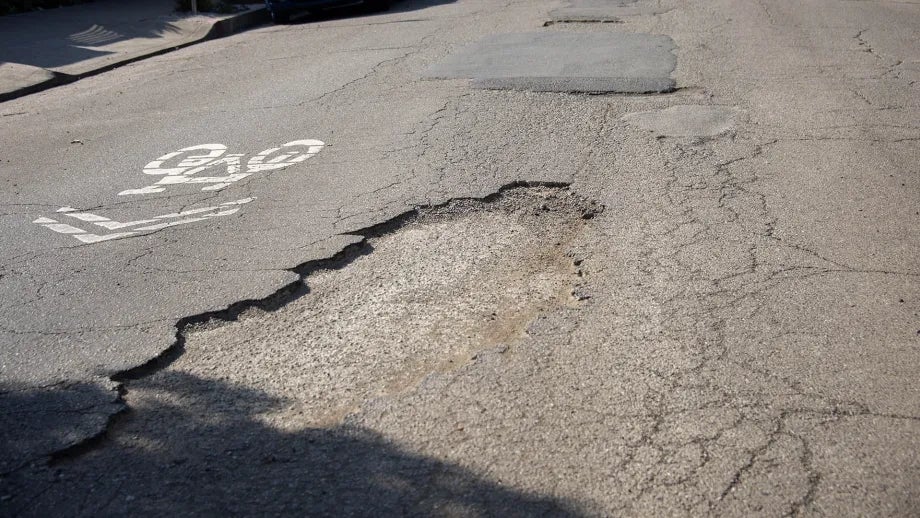Bay Area Pavement Marked by Mediocrity as Pothole Problems Persist
Overall pavement conditions on the Bay Area’s 44,000 lane-miles of local streets and roads landed once again in fair territory last year, with the typical stretch of roadway showing serious wear and likely to require rehabilitation soon. Data released today by MTC put the region’s 2022 pavement condition index (PCI) score at 67 out of a maximum possible 100 points, as computed on a three-year moving average basis. This marks the seventh consecutive year Bay Area streets and roads have registered an average score of 67 and underscores the continuing challenges faced by city and county public works departments.
“The new pavement data continues to be a mixed bag,” commented MTC Chair and Napa County Supervisor Alfredo Pedroza. “The lack of progress toward our goal of bringing all the Bay Area’s streets and roads into a state of good repair is frustrating. At the same time, we’re encouraged that our counties and cities have been able to prevent large-scale deterioration. And the dramatic improvements seen in some of our communities, particularly those where where voters have approved local taxes for street rehabilitation, show us it’s a goal that can be reached.”
PCI scores of 90 or higher are considered “excellent.” These are newly built or resurfaced streets that show little or no distress. Pavement with a PCI score in the 80 to 89 range is considered “very good” and shows only slight or moderate distress, requiring primarily preventive maintenance. The “good” category ranges from 70 to 79, while streets with PCI scores in the “fair” (60-69) range are becoming worn to the point where rehabilitation may be needed to prevent rapid deterioration. Because major repairs cost five to 10 times more than routine maintenance, these streets are at an especially critical stage. Roadways with PCI scores of 50 to 59 are deemed “at-risk,” while those with PCI scores of 25 to 49 are considered “poor.” These roads require major rehabilitation or reconstruction. Pavement with a PCI score below 25 is considered “failed.”
San Francisco, with a three-year moving average score of 74, is the only one of the Bay Area’s three largest cities to rank in the “good” category. San Jose, which has by far the largest street network in the Bay Area at nearly 4,500 lane-miles, recorded a three-year moving average score of 69. Oakland’s three-year moving average rose by two points to 54 (at-risk), but the city’s single-year score fell by one point to 57 from 58 in 2021.
The Sonoma County city of Sebastopol achieved the biggest one-year PCI gains of any Bay Area jurisdiction last year, with its 47 lane-miles of city streets registering a score of 55 (at-risk) for 2022, up 12 points from 43 (poor) the year before. Sebastopol’s three-year moving average score remains in the “poor” category at 48 points.
Other communities with big year-over-year improvements include the Santa Clara County city of Los Altos, which rose 10 points to 75 (good) last year from 65 (fair) in 2021 and the Marin County city of Larkspur, which recorded a 9-point increase to 85 (very good) from 76 (good). Larkspur as recently as 2017 registered one-year scores in the “poor” range but twice in recent years passed local sales tax measures dedicated to rehabilitating the city’s 65 lane-miles of streets. Cloverdale, Emeryville and Pacifica each registered 8-point improvements in their one-year PCI scores for 2022. Pacifica, which has long had some of the lowest average PCI ratings in the Bay Area, logged a one-year score of 49, compared to just 41 in 2021.
Five Bay Area municipalities registered three-year PCI scores in the “very good” range for the 2020-2022 period. These include Orinda (84); Cupertino and Palo Alto (83); and Brentwood, Dublin and unincorporated Solano County (80). Pavement conditions on Orinda streets were in the “at-risk” category in 2012, when voters in the Contra Costa County city approved a quarter-cent sales tax to support roadway maintenance and rehabilitation.
View the complete 2022 Pavement Conditions Summary, including percentages of local roadways in various conditions, and a listing of average PCI scores for the arterials, collector roadways and residential streets for all Bay Area counties and cities.
MTC is the regional transportation planning, financing and coordinating agency for the nine-county San Francisco Bay Area.

